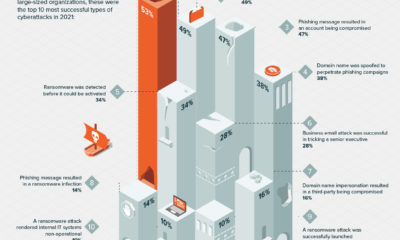The Cybersecurity Boom
How Investors Can Play the Global Explosion in Cyberattacks and Cybercrime
Thanks to Purefunds Cybersecurity ETF (HACK) for helping us put this together. In 1983’s WarGames, a young Matthew Broderick unwittingly hacks into military central computer while searching for video games and almost inadvertently starts World War III. This film is classified on IMDB as in the “Sci-fi, Thriller” genres. While the prospects of cybercrime and cyberterrorism are certainly thrilling (and scary), the descriptor of “Sci-fi” for the movie may no longer be necessary. In the last calendar year, there’s been dozens of high-profile cybersecurity incidents that are not a far cry from the geopolitical near-miss in WarGames. The United States government and the country’s largest bank have both had serious security intrusions as of recent. This summer the United States Government revealed it had over 20 million records stolen by hackers allegedly based in China. Just as concerning, it was exactly one year ago that J.P. Morgan was compromised with records stolen from over 76 million households and 7 million small businesses. The company has now vowed to spend $250 million a year in preventing such incidents. Most recent of all is this week’s hack of the popular adultery site Ashley Madison. The leak of sensitive information on potentially 37 million customers isn’t a potential geopolitical concern as the above cases, but it does have business implications: the website’s plan to raise $200 million in an IPO in London has now been kiboshed for the foreseeable future. If big organizations like Sony, Target, Google, and Home Depot can’t do anything to stop cybersecurity incidents, what chance do the rest of us have? And that’s the problem with cyberattacks. Detected incidents have skyrocketed over the last five years, soaring from 3.4 million to 42.8 million from 2009-2014, and they now cost the global economy an estimated $400 billion a year. Every day these incidents happen on a small scale, but today’s hacking technology and sophistication allows for much more. Exploitation of big cybersecurity vulnerabilities could cause financial chaos, destroy reputations of entire companies, expose business and state secrets, and even shut down moving vehicles remotely. This is not science fiction. This is reality – and we haven’t even gotten into the hypothetical potential damage that hackers could cause if they had even more resources or resolve. People’s lives and money are at stake. Systems are more sensitive and hyperconnected than ever before, and hackers are deploying more sophisticated tactics to take advantage of them for personal or organizational gain. Luckily, there is also an entire industry of engineers, programmers, analysts, designers, cryptographers, and other professionals trying to build the walls and moat around the castle. Cybersecurity, as we depict in this infographic, is a booming industry with hundreds of companies scrambling to protect us from having intellectual property, health records, financial information, and other vital data compromised. That’s why by 2020, the cybersecurity market is expected to be valued at $170.2 billion, which implies a 9.8% CAGR (compound annual growth rate) from today’s estimate of $106.3 billion. Businesses and governments are spending more on cybersecurity: even the Whitehouse announced this year that in its 2016 fiscal budget that it would aim to spend $14 billion on additional measures. Fifteen years ago, cybersecurity was only a blip on the US government’s radar at $938 million in spending. The private sector is in the same boat, as 69% of business executives see cyberattacks as a threat to their growth. This is a fair statement since Verizon estimates in its 2015 Data Breach Investigations Report that the average cost of a cyberattack to a business ranges between $475,000 to $9 million depending on the number of records stolen. Among the companies that are benefiting from the surge in cybersecurity spending include those building firewalls, secure servers, routers, anti-virus software, and malware detection tools. Firms that specialize in consulting and solving related security problems are also getting plenty of interest. Investors can potentially profit from this sector as well by identifying companies and funds that will gain from booming activity and spending in the sector.
on But fast forward to the end of last week, and SVB was shuttered by regulators after a panic-induced bank run. So, how exactly did this happen? We dig in below.
Road to a Bank Run
SVB and its customers generally thrived during the low interest rate era, but as rates rose, SVB found itself more exposed to risk than a typical bank. Even so, at the end of 2022, the bank’s balance sheet showed no cause for alarm.
As well, the bank was viewed positively in a number of places. Most Wall Street analyst ratings were overwhelmingly positive on the bank’s stock, and Forbes had just added the bank to its Financial All-Stars list. Outward signs of trouble emerged on Wednesday, March 8th, when SVB surprised investors with news that the bank needed to raise more than $2 billion to shore up its balance sheet. The reaction from prominent venture capitalists was not positive, with Coatue Management, Union Square Ventures, and Peter Thiel’s Founders Fund moving to limit exposure to the 40-year-old bank. The influence of these firms is believed to have added fuel to the fire, and a bank run ensued. Also influencing decision making was the fact that SVB had the highest percentage of uninsured domestic deposits of all big banks. These totaled nearly $152 billion, or about 97% of all deposits. By the end of the day, customers had tried to withdraw $42 billion in deposits.
What Triggered the SVB Collapse?
While the collapse of SVB took place over the course of 44 hours, its roots trace back to the early pandemic years. In 2021, U.S. venture capital-backed companies raised a record $330 billion—double the amount seen in 2020. At the time, interest rates were at rock-bottom levels to help buoy the economy. Matt Levine sums up the situation well: “When interest rates are low everywhere, a dollar in 20 years is about as good as a dollar today, so a startup whose business model is “we will lose money for a decade building artificial intelligence, and then rake in lots of money in the far future” sounds pretty good. When interest rates are higher, a dollar today is better than a dollar tomorrow, so investors want cash flows. When interest rates were low for a long time, and suddenly become high, all the money that was rushing to your customers is suddenly cut off.” Source: Pitchbook Why is this important? During this time, SVB received billions of dollars from these venture-backed clients. In one year alone, their deposits increased 100%. They took these funds and invested them in longer-term bonds. As a result, this created a dangerous trap as the company expected rates would remain low. During this time, SVB invested in bonds at the top of the market. As interest rates rose higher and bond prices declined, SVB started taking major losses on their long-term bond holdings.
Losses Fueling a Liquidity Crunch
When SVB reported its fourth quarter results in early 2023, Moody’s Investor Service, a credit rating agency took notice. In early March, it said that SVB was at high risk for a downgrade due to its significant unrealized losses. In response, SVB looked to sell $2 billion of its investments at a loss to help boost liquidity for its struggling balance sheet. Soon, more hedge funds and venture investors realized SVB could be on thin ice. Depositors withdrew funds in droves, spurring a liquidity squeeze and prompting California regulators and the FDIC to step in and shut down the bank.
What Happens Now?
While much of SVB’s activity was focused on the tech sector, the bank’s shocking collapse has rattled a financial sector that is already on edge.
The four biggest U.S. banks lost a combined $52 billion the day before the SVB collapse. On Friday, other banking stocks saw double-digit drops, including Signature Bank (-23%), First Republic (-15%), and Silvergate Capital (-11%).
Source: Morningstar Direct. *Represents March 9 data, trading halted on March 10.
When the dust settles, it’s hard to predict the ripple effects that will emerge from this dramatic event. For investors, the Secretary of the Treasury Janet Yellen announced confidence in the banking system remaining resilient, noting that regulators have the proper tools in response to the issue.
But others have seen trouble brewing as far back as 2020 (or earlier) when commercial banking assets were skyrocketing and banks were buying bonds when rates were low.













